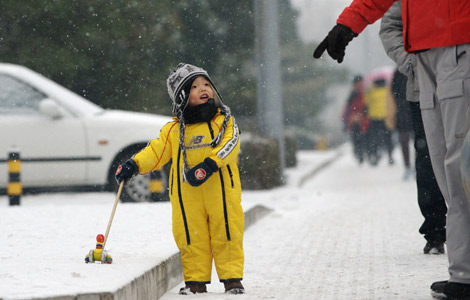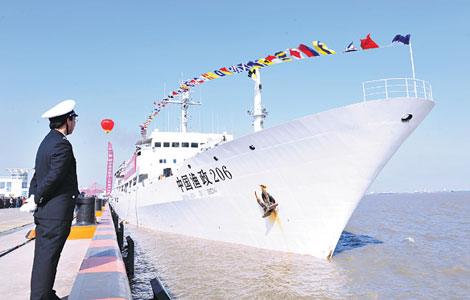
Chinese agricultural scientists show the way toward sustainable agriculture in Rwanda
According to ancient Rwandan folklore, eating mushrooms would lead to the death of cows, a symbol of wealth in Rwandan culture. Such was the taboo against mushrooms, that despite being rich in nutrients and having immense health benefit, it did not find a place in the Rwandan cuisine dominated by staples like cassava, corn and potato.
With such a stigma against it, Rwanda would be the last place where one would expect mushroom cultivation to be a lifeline for farmers.
Not only have times changed, but also culinary habits. The once-shunned mushroom is now a much sought after ingredient in Rwanda for soups, salads, and sandwiches among other things.
Though the mushroom acceptance was triggered by several factors, its genesis can be traced to the pioneering efforts made in Rwanda by a group of Chinese agricultural scientists from Fujian Agriculture and Forestry University.
"Changing the local dietary practices was an extremely challenging task as we had to overcome hurdles like tradition and culture. But we were lucky in our efforts, and many of the Rwandese have realized that mushrooms are an environment-friendly, high-profit and nutritional industry," says Lin Yingxing, head of the China-Rwanda Agriculture Technology Demonstration Center.
Lin, a professor from the Fujian university, is also a well-known expert on edible fungus technology or juncao (literally meaning fungus grass).
"Our technology focuses on improving the fertilizer ingredients needed for mushroom cultivation. We mainly use withered grass and residue from other agricultural activities to grow mushrooms," he says.
"This is a more sustainable and environmentally friendly practice, unlike conventional techniques that are reliant mostly on wood."
Lin and his team of agricultural experts and researchers from the Fujian university set up the C-RATDC in April 2011 and have been working at the center since then. The center is one of the 14 such facilities that China agreed to set up for reinforcing economic aid to Africa during the Beijing Summit of the China-Africa Cooperation Forum in 2006.
Located at Rubona in Butare of Huye district of Southern Province in Rwanda, the sprawling facility encompasses classrooms, production facilities, demonstration workshops and staff quarters.
Introducing mushrooms to Rwanda was a plan that was formulated after evaluating the success achieved by similar programs in other nations, Lin says.
"Our first overseas juncao mushroom cooperation project was in Papua New Guinea in 1995," Lin says. "Later on we set up similar projects in Lesotho, South Africa and some other African countries."
The biggest advantage of growing mushrooms is that it is a low-cost process that gives quick returns, he says.
"To popularize mushroom cultivation in Rwanda, we decided to focus and support women's associations, orphanages and nursing homes for the aged as we felt it would give them a safe and easy way to earn their livelihood," Lin says, adding that young college graduates who are eager to start their own business are now among his frequent visitors.
Bakayihinda Marthe, president of the Cooperative Abartuhuje Ngoma, a women's association, whose members are mostly widows from the genocide in 1994, says the innovation and knowledge provided by the Chinese experts have proved to be extremely valuable.
"This is really an affordable and simple business and gives us steady returns," she says. "We have learned that mushrooms can play a big role in improving the overall nutrition levels of our people."
The younger generations of Rwandans who want to make mushroom cultivation a permanent affair find the Chinese expertise a steady pillar of support.
"C-RATDC means permanent technical assistance from experts and a crucial factor in our business expansion plans," says Uwammariya Marie Chantal, chairman of Agrocare Cooperative, an association set up by graduates from the National University of Rwanda.
"Their constant direction, frequent updating of knowledge and supply of good quality mushroom tubes are important factors in the success of our business," he says.
Apart from juncao mushroom production, the center also concentrates on rice production techniques, soil and water conservancy and sericulture technology. All these plans are complementary to each other and contribute to water conservancy, while residue from sericulture and rice production can also be used for mushroom cultivation.
"We have five functions at this technology demonstration center — adaptability research and experiments, breeding high quality seeds, training, technology and skills demonstration and promotion, as well as small-scale production and processing of mushroom, crops and silk products," says Lin Zhansen, another professor at the center.
The center has so far organized 16 short-term training courses in association with local agricultural departments, he says.
"I have been researching and promoting paddy cultivation in China and based on my findings, I am confident of increasing the quality and productivity of rice yields in Rwanda," says Huang Shuiming, a researcher from the C-RATDC.
Huang has designed and jointly conducted courses on paddy rice growing along with field trials.
"Theories and skills delivered during this course are extremely practical and designed in such a way that it suits the social and natural conditions of Rwanda," he says.
Nshimiyimana Etieniye, a Rwandese student, says they have acquired extensive knowledge on several novel rice cultivation techniques.
"It is new for the Rwandan rice industry. We are committed to working closely with the Chinese experts to popularize the rice cultivation techniques all over Rwanda," Etieniye says.
At the same time, he says that focusing on rice cultivation alone is not enough and more exchanges on other agricultural technologies like water and soil conservation techniques and on cultivation of crops like mushroom using agricultural residue like rice straw are needed.
Bunani Jean, a technician in the rice program of the Rwanda Agriculture Board, says agriculture has played a vital role in achieving the self-reliance goal for several farmers.
"We pay the transportation and accommodation fees for selected students across our country, to show our dedication to work with the Chinese experts at the center to advance our knowledge in agriculture," he says.
Though the center is functioning on a three-year contract, the Chinese experts are confident there will be more cooperation between the two sides in the long term.
"Three years is too short a time for agricultural projects as the experiments alone take more than half of this time," Lin says.
"We hope that more time would be granted when the contract is renewed so that we can reach out to more local people."
Lin says that though he feels the obligation and responsibility on his shoulders, his actions are guided by the nature of the center and its capacity.
"We are not a company, but a technology demonstration center. This means that the focus of our job is not to make profits, but to help people, and hence our financial capabilities are also limited," he says.
"For instance, we can send the first few batches of mushroom tubes free of charge to university graduates and women's organizations to help them establish their own business. But due to lack of people and finance, we can't keep on doing so."
He also feels that agriculture progress should go hand in hand with technology advances. If this happens, agricultural technology alone would be more than enough to ensure prosperity, he says.
"Our sericulture technologies are already facing unexpected challenges and moving away from their initial plans," says Lin. "Most of the farmers who have raised mulberry and cocoons are struggling for survival as there are no silk processing facilities in Rwanda, and hence no buyers."
lilianxing@chinadaily.com.cn








